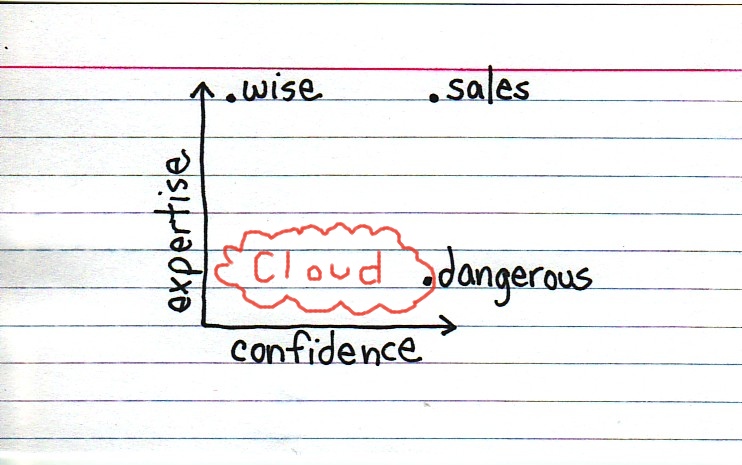Although I will resist the obvious and hackneyed cloud metaphors and similies, it is painfully clear that the field of cloud computing remains ill-defined. As we (hopefully) near the apex of hype, just about every IT company is clamoring to be part of the cloud market. From data center build-out to storage arrays to server hosting to consulting, every area of IT is seeing the same old names raising their hands as part of this new space.
Experts, Pragmatists, Iconoclasts, and Curmudgeons
Predictably, many folks are decrying this “cloud-ification” of sales pitches. They all seem to be taking up one of the following tactics:
- I’ve got it all figured out: I know what cloud is and I’m going to shout down everyone who (according to me) uses the term wrong!
- Let’s all get along: We should work together now to decide what is and isn’t cloud and what the use cases ought to be and then apply this model to everything we see.
- It’s all cloud, so let’s all be friends and get a bigger tent!
I’d like to suggest an alternative approach: It’s still way too early to figure out what cloud is, so let’s all just work as hard as we can to move things forward without voting anyone off the island yet. I am the first to admit that I get frustrated when I see unlikely hands raised in response to the question of what is and isn’t “cloud”, but who am I to know?
SaaS and NIST
Part of the impetus for this thought was the exchange this weekend between two admirable folks, John Treadway and Christofer Hoff. Hoff (aka @Beaker) kicked things off with a blog post suggesting that certain software-as-a-service offerings aren’t really cloud computing. See, they don’t really meet a specific set of requirements put forth by certain folks in the cloud computing community and embodied in the National Institute of Standards’ cloud computing definition. Hoff’s argument was sound, as long as one accepts the NIST definition.
Treadway (aka @CloudBzz) responded that the NIST definition wasn’t necessarily a great test for cloudiness since it seems a bit off the mark. Specifically, it seems much more focused on the infrastructure (how you do it) side of things than the software (what you do) angle. So it’s no surprise that software-as-a-service doesn’t match up well. The discussion continued on Twitter, where other folks, including me, weighed in as well.
An Ocean of Air
Assuming you read this whole post, I’m sure you can guess where I fit in, and what my response was. The idea that a panel of experts and a government agency has reached a definitive definition of cloud computing at this early stage in its development is ludicrous. Although I respect the NIST document and admire the effort that went into its creation, I’m betting that it will look laughably parochial once more dust has settled. Since this point is just a few years off, let’s all bite our tongues when it comes to preempting discussion about the cloud!
Image adapted from Indexed, July 23, 2009
Hoff shared another item this weekend which illustrates this conclusion. The graph (adapted above) ought to take the hot air out of the cloud experts everywhere. Since we certainly cannot posess any great expertise about something in its infancy like cloud computing, no one is really wise. In fact, we’re all still awfully close to the low point on both axes!
© sfoskett for Stephen Foskett, Pack Rat, 2009. |
Cloud Curmudgeons
This post was categorized as Enterprise storage, Everything, Gestalt IT, Personal, Virtual Storage. Each of my categories has its own feed if you’d like to filter out or focus on posts like this.



What you mean to say is..
http://www.dilbert.com/strips/comic/2002-10-04/
What you mean to say is..
http://www.dilbert.com/strips/comic/2002-10-04/